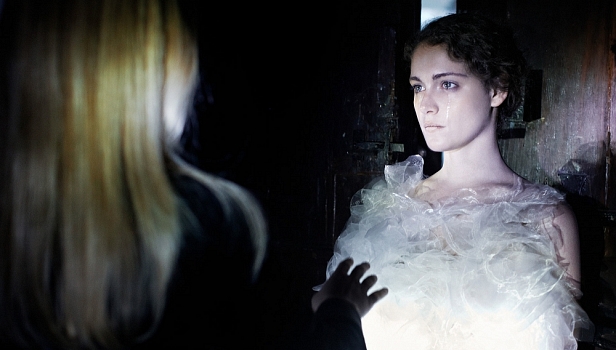By providing your information, you agree to our Terms of Use and our Privacy Policy. We use vendors that may also process your information to help provide our services. This site is protected by reCAPTCHA Enterprise and the Google Privacy Policy and Terms of Service apply.
Locarno Review: Why Athena Rachel Tsangari’s ‘The Capsule’ Is More Than a Twisted Fashion Show
Eric Kohn

 Greek director Athina Rachel Tsangari’s terrific coming of age drama “Attenberg” was largely about a young woman coming to terms with her body. While playfully irreverent and sometimes borderline surreal, “Attenberg” nevertheless rooted its exploration in a conventional storyline made fresh. Tsangari’s 35-minute avant garde follow-up “The Capsule,” one piece of a installation work commissioned by the DesteFashionCollection, advances similar ideas in lively, shocking abstractions. It is truly a capsule of the filmmaker’s vision boiled down to radical expressivity.
Greek director Athina Rachel Tsangari’s terrific coming of age drama “Attenberg” was largely about a young woman coming to terms with her body. While playfully irreverent and sometimes borderline surreal, “Attenberg” nevertheless rooted its exploration in a conventional storyline made fresh. Tsangari’s 35-minute avant garde follow-up “The Capsule,” one piece of a installation work commissioned by the DesteFashionCollection, advances similar ideas in lively, shocking abstractions. It is truly a capsule of the filmmaker’s vision boiled down to radical expressivity.
Commissioned by art collector Dakis Jaonnaou, “The Capsule” is less pure cinema than a mixed media deliberation on identity. The narrative, if you can call it that, follows a group of seven stone-faced women awakening by candlelight in a creaky mansion perched at the top of a Cycladic rock and engaging in a bizarre series of ritualistic endeavors for their apparent matriarch before receding back to their lair. A few of their faces ring familiar, such as “Attenberg” actress Ariane Labed and Clémence Poésy, whose previous credits include episodes of “Gossip Girl” and the last two “Harry Potter” movies. In “The Capsule,” however, the setting and exceedingly strange events quickly defamiliarize them. Adorned in deeply expressionistic and revealing outfits while engaging in wildly unpredictable and sometimes blatantly animalistic behavior, the women transform into unadulterated ideas.
In the opening minutes, the residents of the castle rise from a series of increasingly absurd hiding places: beneath a pile of chairs, hidden behind a vase, emerging in miniature from the mouth of another woman and then hidden within the crevice of a human face peeled off to reveal the captive within. Lining up in sun-kissed hallways, their heads spin 360 degrees as they hiss at each other like restless felines — which one of them eventually morphs into by way of handrawn animation superimposed on the screen.
Tsangari’s barrage of experimental conceits start to drizzle in these early scenes, but once it rains, it pours. The longest sequence of “The Capsule” finds the woman leading goats in slo-mo to a nearby area where they perform a series of confessionals for their overseer in addition to a deadpan rendition of “A Horse With No Name.” Never fully engaged in conversation or displaying much emotion, their collective identity is entangled with their hyperbolic outfits, which in no uncertain terms advertise costume design by the likes of Marc Jacobs, Bordelle and Tsangari herself. But even as it shows off the clothes, “The Capsule” maintains its captivating edge, interrogating the roots of sexuality and forcing viewers to sort through it.
 Produced in conjunction with a video installation that recently screened in the window of Barneys in New York City, Tsangari’s project reflects the DESTE Foundation’s stated intention “to draw parallels between the actual objects and the artist/curator’s interpretations” with new work commissioned on an annual basis. The multiple dimensions to “The Capsule” expand this notion into several contexts. (To reflect its extreme dimensionality, the projected work contains a 3-D component.) Viewed on its own terms, however, this concise movie-thing gets the job done.
Produced in conjunction with a video installation that recently screened in the window of Barneys in New York City, Tsangari’s project reflects the DESTE Foundation’s stated intention “to draw parallels between the actual objects and the artist/curator’s interpretations” with new work commissioned on an annual basis. The multiple dimensions to “The Capsule” expand this notion into several contexts. (To reflect its extreme dimensionality, the projected work contains a 3-D component.) Viewed on its own terms, however, this concise movie-thing gets the job done.
Eventually a lesbian vampire dance piece about bodily urges, “The Capsule” cogently explores the ability of material objects to relate sensuality through their reflection of otherwise inexpressible desires. A feminized take on Matthew Barney’s “Cremaster Cycle” in a tightly wound half hour experience, “The Capsule” is finally about a universal moment of revelation. “You don’t know what you are,” the leading lady eventually tells her followers. “You are woman.” While she cautions them that “this infinite cycle must end,” Tsangari in fact shows it in a constant state of renewal.
Criticwire grade: A-
HOW WILL IT PLAY? Its brevity is not the only reason why “The Capsule” won’t receive a conventional release, but the fashion hook opens it up to more complex fine art displays. It should enjoy special attention at festivals and fashion shows alike.
By providing your information, you agree to our Terms of Use and our Privacy Policy. We use vendors that may also process your information to help provide our services. This site is protected by reCAPTCHA Enterprise and the Google Privacy Policy and Terms of Service apply.

















